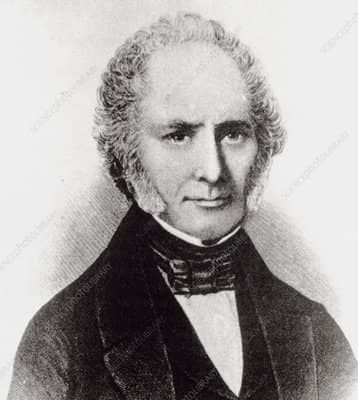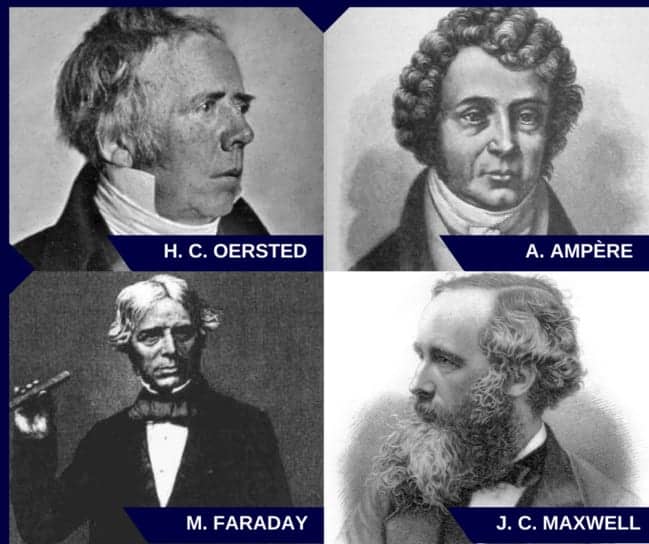To understand the electromagnet, it is helpful to take a moment to learn about its inventor, William Sturgeon. Sturgeon’s life was dramatic and inspirational, although his hair and sideburns were, in my opinion, bizarre. So, take a few minutes and learn why a poor shoemaker and soldier would invent the electromagnet and how it works.
Table of Contents
William Sturgeon’s Early History
How Oersted, Faraday and Ampère Influenced Sturgeo
Sturgeon’s Discovery of the Electromagnet
Influence of the Electromagnet
Video Script Download
William Sturgeon’s Early History

William Sturgeon was born in 1783 in Northern England to a poor shoemaker who treated him badly.
When he was ten his mother died and a few years later his father basically sold him to another shoemaker who also treated him cruelly and according to him he lived a life of “slavish drudgery.” When he was 19 years old, Sturgeon escaped by joining the army.
The army was good for Sturgeon.
He found that the officers in particular were appreciative of his skill at fixing things, especially their shoes! He would also entertain the officers and fellow troops with amateur science demonstrations that he invented himself.
Sturgeon then traded his services to officers for lighter duties and to borrow their books (remember, at this time there were no libraries and books were prohibitively expensive).
In this way, he actually taught himself Math, Greek, Latin, French, German, Italian, optics and lithography!
After 18 years in the army Sturgeon retired and moved to the Woolwich district of London.
His plan was to start a shoe store.
For that reason he contacted some officers who he knew from the military. However, many of them were interested in the latest developments in science and asked Sturgeon for help with their scientific devices as well as their shoes.
How Oersted, Faraday and Ampère Influenced Sturgeon

It was fortunate timing because in that same year, Hans Oersted in Denmark had discovered that current in a wire moves the magnet in a compass.
One of the things that was intriguing about Oersted’s experiment was that Oersted discovered that when current went down a wire it would force magnets to point in a circle around the wire.
For that reason, Oersted incorrectly decided that the current wasn’t going down the wire but instead was spiraling inside the wire. In France, a man named Ampere read Oersted’s paper and started to do a series of experiments about electricity and magnetism.
For example, Ampere determined that two parallel wires with current in it would feel an attractive force between them. Ampere’s experiments were so influential that current is measured in Amps in his honor.
One day Ampere was thinking about Oersted’s theory that current was spiraling in a wire and wondered what would happen if the wire itself was spiraling. Ampere thus coiled up a wire in a helix and studied the magnetism created by the current.
The next year, a young Englishman named Michael Faraday published his theory that we still believe today, that electricity is really flowing straight down the wire, and, improbably as it seems, somehow creating a circular force field around it.
He also stated that the force fields from multiple wires work with each other in what he called “compound action”.
For example, Faraday interpreted Ampere’s experiment with two wires that feel an attractive force as the compound action of the magnetic fields from the wires supported each other.
Faraday also said that Ampere’s spiral coil also demonstrated how the fields were additive from parallel wires as if you look at a coil it is composed of many parallel wires.
Faraday also noted that a coil of wire with current in it acts identically to a bar magnet, albeit a weak one.
Sturgeon’s Discovery of the Electromagnet

Let’s go back to William Sturgeon. By 1824, Sturgeon’s friends had helped him get a job giving science demonstrations at a military academy and he gave up shoemaking to focus on science.
Therefore, he had time to read Ampere’s and Faraday’s papers and to try to recreate their experiments and to see if he could bump them up a notch.
One day, Sturgeon was experimenting with Ampere’s coil by wrapping a coil of wire around an iron bar. To his surprise, the iron bar amplified the magnetic effects of the coil! Because the electricity in the wire makes the iron act like a magnet, this object is called an electromagnet.
Let’s take a moment to go over the magnet and the electromagnet.
A permanent magnet always contains a North and a South. A North and a North will repel each other, a South and a South will repel and a North and a South will attract.
You can visualize this using the magnet in a compass, the North of the compass will point towards the south end of the magnet and away from the North end. Permanent magnets can also attract certain metals that are not magnets.
For example, if a magnet is placed near a paper clip, the paper clip will be attracted to the magnet.
This is because the paper clip is made of steel and steel is composed of little magnets (or magnetic domains) that are randomly arranged.
When the paper clip is near the magnet, the little magnetic domains line up, making the paper clip into a temporary magnet where the North of the paper clip is attracted to the South of the magnet. You know an object is a magnet if it attracts and aligns a metal paper clip.
Now lets talk about an electromagnet.
An electromagnet is a coil of wire wrapped around an iron or steel bar.
Without current, the bar will not attract paper clips or act like a magnet at all.
However, if current runs through the wire, then the magnetic fields in the wire align the magnetic domains in the iron bar and make it act like a magnet with a North and a South.
The bigger the current, the stronger the magnet.
Amazingly, if the + and minus connections to the battery are switched, the North and the South of the electromagnet switch as well! Also, once you disconnect the battery, the iron basically stops being a magnet.
In 1826, Sturgeon found that if he wrapped wire around a u-shaped iron bar he could create a u-shaped magnet.
It was so strong that even with the weak batteries at the time and with just a few turns of coil an electromagnet could hold 9 pounds of weight and then drop it dramatically when the current was disconnected!
Influence of the Electromagnet
Sturgeon was awarded a silver metal for this discovery as well as thirty guineas.
At the time, everyone thought that the big advantage of electromagnets was to make theatrical demonstrations.
However, it turns out that a magnet that one can control electrically is far more influential and useful than anyone supposed at the time. Electromagnets were vital components used in the invention of almost all electrical devices like the telephone, the electric generator, the radio, the x-ray machine, and the television to name just a few.
One of the first important devices that used Surgeon’s electromagnet was the electromagnetic telegraph.
See, in 1827, a paper about Sturgeon’s device made it all the way to the backwoods of New York State. A bored math teacher named Joseph Henry read about it and invented the telegraph.
Then, a racist egoist named Samuel Morse (like Morse code) stole his ideas and fame.


Pingback: Ohm's Law: History and Biography of George Ohm - Kathy Loves Physics